Visiting the gold rush towns in California is the best way to discover the ancient and rich past of the state, as these California gold rush towns changed the economy and culture of the people forever, significantly changing the lives of the settlers and merchants migrating to these towns in large numbers.
If you love history, you must visit these gold rush towns in California to be introduced to interesting tales of the towns, right from the story of the first search for the treasure to the lives of the miners and merchants that shaped the future of the California towns known for gold rush.
Regular readers know that I love history, and I have had the chances to explore these gold rush towns in California on one of the many road trips and weekend getaways. In this post, I share all about these towns, a bit of interesting stories and anything else you need to know to plan a fabulous trip.
TOP GOLD RUSH TOWNS IN CALIFORNIA
SIERRA CITY
Sierra City is one of the first mining camps on the list of Gold Rush Towns in California and is located North of the Yuba River, near Lake Tahoe.
The city, which sits on the foothills of Sierra Nevada, has existed since 1850 and was on the boom during Gold Rush.
This Gold rush town was renowned for Kentucky Mine Stamp Mill, which operated for nearly 100 years until 1942.
Today, you can take a guided tour of the Kentucky Mine Historic Park and Museum to understand the preserved Gold mining history and experience the day in the life of a gold-seeking miner.
Explore the historic buildings, mining equipment and machinery and other well-maintained artefacts. They are brought to life twice a day during the tours.
If you are sensitive to loud noise, it is advisable to wear earplugs and also safety glasses.
The Museum will be open from Memorial Day to labour day weekend from 10 AM to 4 PM.
The guided Gold mine and stamp mill tour lasts from 11 AM to 2 PM. Admission: $10 for adults and $5 for children.
The stamp mill also has a cave-in, home to many bats. You might even see them close up if you visit during the right season.
Fun Fact: The largest gold nugget, which weighed around 106 troy pounds, was found in this location!
DOWNIEVILLE
Located in the Sierra Nevada mountains of Northern California, Downieville is one of the historic Gold Rush Towns in California.
It is often referred to as “The Forks” since it is located on the point of confluence of the Downie River and the North Fork of the Yuba River.
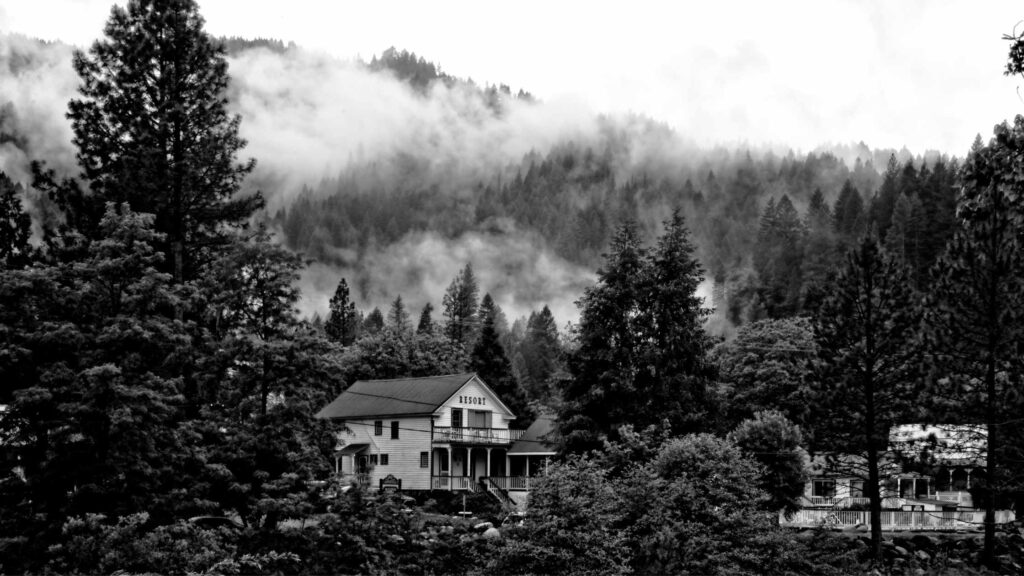
The town was named Downieville after its founder William Downieville.
Later in 1849, Downieville came into prominence when Francis Anderson discovered Gold.
The area was so rich in Gold that the founders were able to establish hotels, bakeries and lavish saloons and bars in most parts of the state.
Get to know about the history of this beautiful town at the Downieville Museum, located on Main Street and housed in a former bank building.
The Museum is a treasure trove of artefacts and stories that tell the story of this small town and its residents.

Look at the mining exhibits, farming and logging tools and learn about the development of Downieville during the Gold rush era.
Shop on Main street, which offers a great selection of shops. Check out unique shops for your antique and souvenir collections.
Downieville is a hotspot for mountain bikers and hikers, which offers around 65 miles of rustic trails on rugged terrain suitable for all age groups. The trails provide incredible valley views.
Take a dip in the refreshing waters of the Yuba river, or try reeling in some trout and bass. Enjoy White water rafting, Kayaking or Canoeing on the clean waters of the Yuba river.
TRUCKEE
Truckee, nestled in the Sierra Nevada much closer to Lake Tahoe, is one of the famous Gold Rush Towns in California. The city named after the Truckee river was known for its lumber and ice-harvesting.
Truckee was a hotspot for sledge runs and ice rinks in the 1890s, which made it a popular tourist destination.

Thanks to the favourable weather, you will find the river in full gush during the warmer seasons and enjoy the beautiful snow-capped mountain vistas in the backdrop.
This Gold rush town is also incredibly charming and offers endless things to do, such as hiking, mountain biking, Kayaking and fishing.
Check out the nearby Donner Lake, an ideal location to spend your vacation or summertime with your family.
The Lake is one of the local’s favourites for skiing, snowshoeing, camping and picnic lunch.
If you want to hike in Truckee, head to Johnson Canyon. The trail is unpaved and will be dotted with vibrant wildflowers. The hike is comparatively easy, and you will get incredible vistas of Donner Lake.
For more adventure, head to Truckee river, a hotspot for white water rafting and tubing.

If you are into history, visit the Donner Memorial State Park, a National Historic Landmark located 5 minutes away from Truckee, to learn about the Donner Party exhibits.
The state park is home to cabin sites, and it also screens informative videos narrating the history of Truckee.
The Old Town of Truckee is pretty and has quaint shops, restaurants and galleries. Some quirky shops will take you through the history of this historic railroad town.
This will be a unique shopping and browsing experience since you might hear trains whistling while you shop.
Grab your favourite drink from one of the many bars and breweries in the Old town.
NEVADA CITY
Nevada city, located in the Sierra foothills, was established in 1849. It was one of the prominent Gold Rush Towns in California and was renowned for its victorian architecture and historic buildings.
Being one of the region’s largest and most profitable mining camps, the gold seekers could easily pull out a pound of Gold from Dry Creek.
The streets were lined with elegant saloons and gambling houses. Eventually, families and early migrants started to settle in.

Nevada has had its share of the glorious past, and today it is known for its well-preserved historic buildings, boho vibes, charming bars and a plethora of things to do.
Check out the National Exchange Hotel, one of the oldest operating hotels in the West.
Visit the nearby historic Nevada theatre, California’s oldest existing theatre building, which was opened in 1865.
The Nevada Theatre is also listed on the National Register of Historic Places since 1973.
The theatre hosts Nevada City Film Festival every summer and the Wild & Scenic Film Festival every Winter.
Watch your favourite plays, and don’t miss out on the recently added Murals, which are gorgeous.
If you want to explore more of Nevada City, go on a 40-minute drive to reach the outskirts of town and visit Malakoff Diggins Site.
This was a hydraulic mining camp which was founded in 1851. Extensive use of hydraulic digging for mining caused the deterioration of the landscape, which led to the establishment of environmental laws.
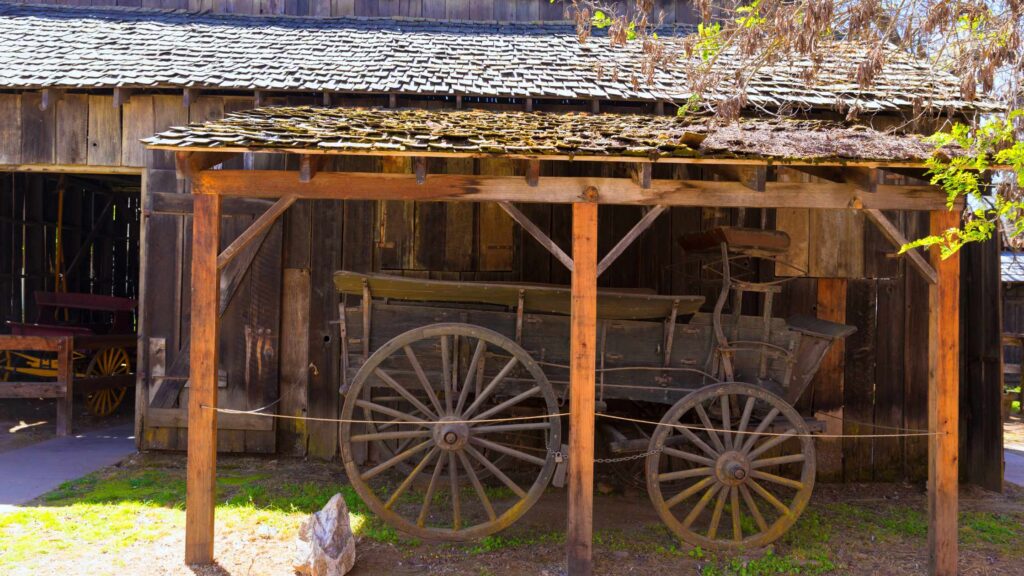
Enjoy reading the history of hydraulic mining as you stroll through this beautiful area, imagining the hustle and bustle it once held. There are plenty of well-maintained trails to reach this site.
You might see bears, lizards, and colourful butterflies as you explore this preserved town of North Bloomfield. The trails are ADA-accessible and greet you with vibrant wildflowers.
If you want a car to drive around Nevada city, check out Discover Cars, they offer a wide range of cars with affordable pricing options.
Nevada is home to many state parks with beautiful hiking trails. Check out the Donner Memorial State Park, Tahoe National Forest, South Yuba River State Park, and Pioneer Cemetry for some fantastic vistas of the Sierras.
Unwind on the shores of Yuba river, an excellent spot for fishing, swimming, hiking and camping. Plenty of biking trails around the river take you through the dense forests and canyons.
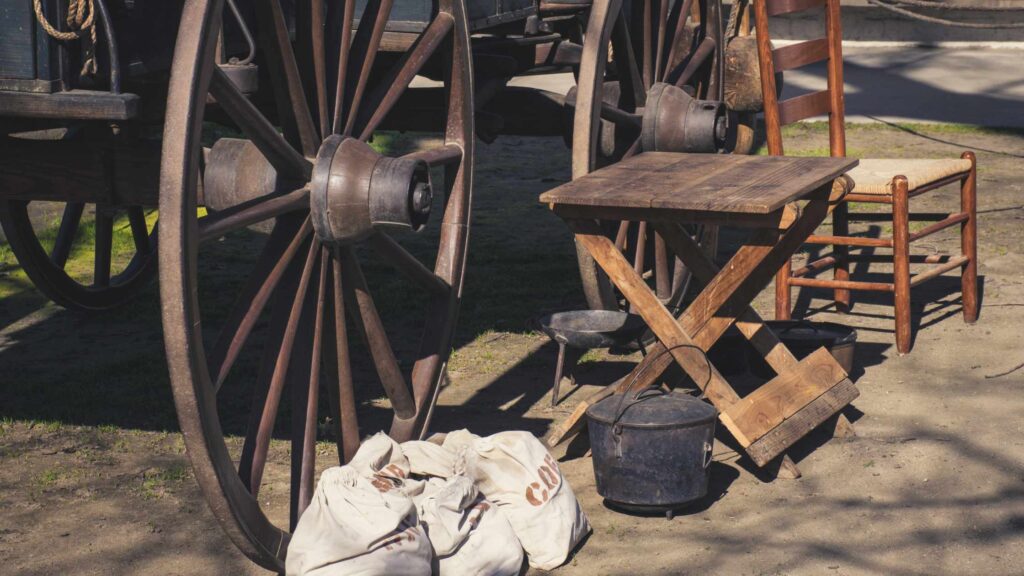
Check out the Angkula Seo Suspension Bridge, a hidden gem near Nevada City. Don’t miss the bridge, especially if you are doing the Deer Creek hike to have a magical experience amidst towering pines.
The North side of this bridge has many stone beaches to relax and take in the beauty of the surrounding vistas.
Drive around 10 miles South of Nevada City to explore the Empire Mine State Historic Park in the Grass Valley.
The park combines one of California’s most affluent, oldest and most productive gold mines with a vast and beautiful park.
Take a guided tour to explore the historic buildings, the up-and-running blacksmith shop, mine exhibits and several other beautiful trails around the mine. Buy an admission ticket for $5.
Fun Fact: A massive 5.8 million ounces of Gold was extracted from this mine before it closed in 1956.
If you are a museum and a history buff, check out the Old Jail Museum, a 19th-century jailhouse that used to hold prisoners around the city for almost 90 years from 1875 to 1964.
Take a guided tour at the Nevada County Narrow Gauge Railroad Museum to learn more about the history of railroads and aviation.
Visit the Nevada County Historical Society and Museum to learn more about the history of this charming gold rush town.
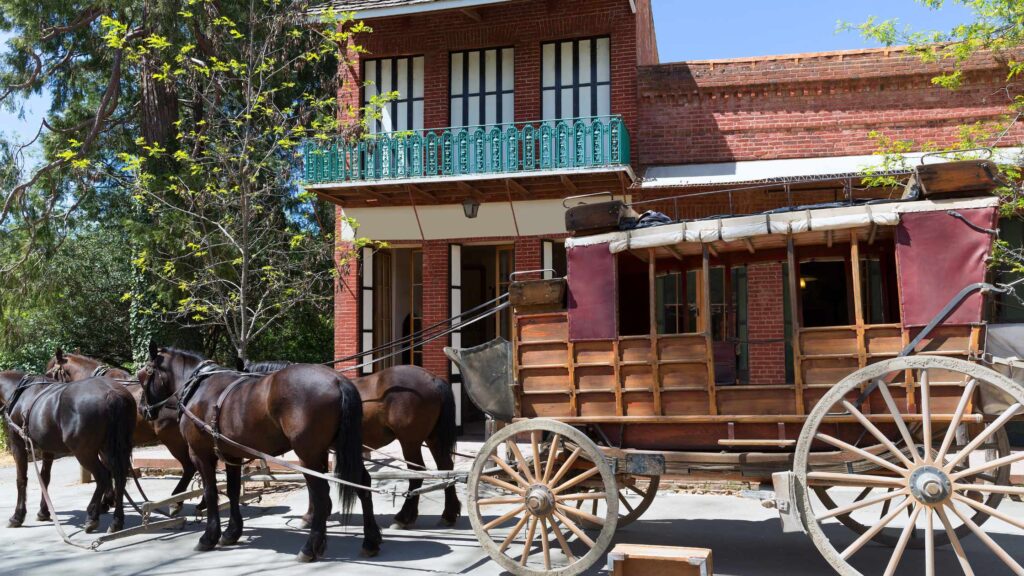
For a unique shopping experience, check out the Nevada City Farmers Market, held on every Saturday.
Make acquaintance with local vendors, learn about handmade crafts, and buy fresh local produce and baked items.
Finally, not to miss the heart of Nevada City, the historic district downtown area lined up with many themed restaurants, bars, boutique shops and vintage treasures along Main street and Commercial Street.
Admire the beautiful buildings restored after a massive fire breakout in 1863.
If you want more of an 1870s experience, take a driving tour to explore some of the best-preserved homes in the Gold rush town.
Explore East Broad and Broad and head to Nevada and Boulder Streets to witness towering Victorian buildings once home to the mine owners.
GRASS VALLEY
If you are looking for Gold Rush towns near Sacramento, visit Grass Valley, one of the charming towns renowned for its vast mining history.
The town was established in the mid-1800s, and it rapidly became a bustling centre for miners and pioneers with the discovery of Gold in Quartz.
Grass Valley was known for its extensive mining camps at the foothills of the Sierra Nevada, with Idaho-Maryland being the largest mine in the region.
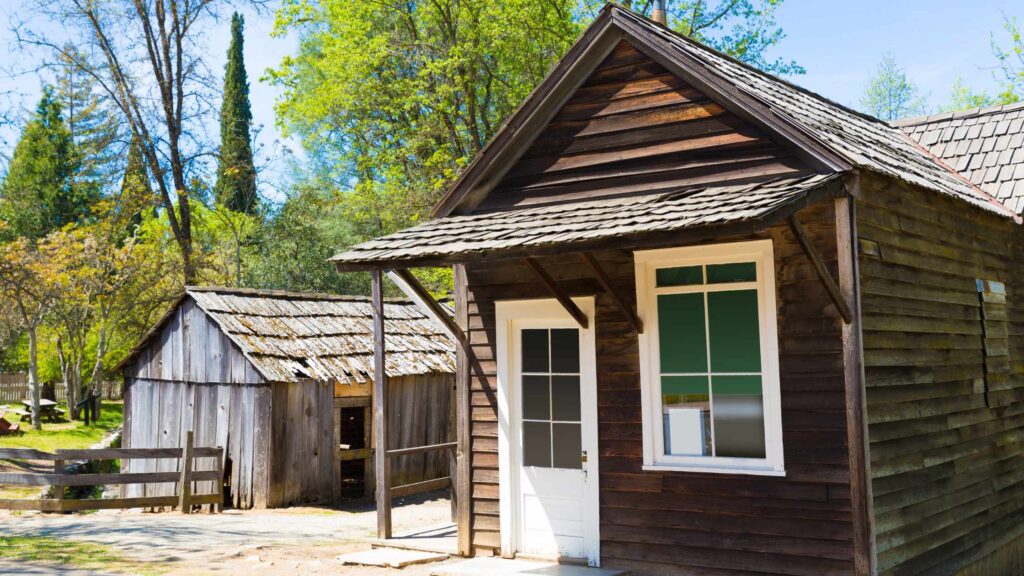
The mine was remarkably popular for its rich ores, and the mining continued for nearly 80 years.
This is evident from the large number of old mining equipment scattered around the town.
There are many activities in this Californian Gold Rush Town.
With its rolling hills, lush green meadows and beautiful landscape, Grass Valley is home to some of the most spectacular landscapes in the state.
Take a guided tour of the Northstar Mining Museum and the Empire Mine State Historic Park, spread across 900 acres, one of California’s oldest and richest gold mines.
The mine was owned by William Bowers Bourn Jr. and operated from 1850 to 1956.

It is said that the miners dug over 367 miles of tunnel. On tour, you can see the blacksmith shop, mining equipment and exhibits, a Cotswold-style cottage, and an illuminated mine shaft.
Don’t miss “The Secret Room”, which is no longer a secret now. The room contains a scaled model of the entire mine. The park is also home to 14 miles of beautiful hiking trails.
Empire Mine State Historic Park also features events like Miners Picnic, which has been in the town for the past 125 years.
Check out other events like Holiday Open House and Springtime at the Mine.
Stroll along the vibrant Grass Valley downtown, dotted with historic storefronts, antique shops, chic boutiques, art galleries, museums, organic grocery stores and other cultural venues.
Visit the two beautiful bookstores in town to cater for your interest towards history and, if you are a nerd like me, fill your suitcases with literary treasures.

Check out The Shops at the Nevada County Bank, and don’t miss Lazy Dog Chololateria, a cute retro candy store.
If you visit the Grass Valley during October, you will be greeted with downtown decorations for Halloween; it will be like one of the Hallmark movie scenes.
End your day with a pint of your favourite brewed beer at the Grass Valley Brewing Company, known for its ales and stouts, along with some mouth-watering cuisines.
AUBURN
Known as the “Heart of the Gold Country”, Auburn is one of the best Gold Rush Towns in California, located in Placer County near the Sierra Nevada foothills, 30 minutes South of Grass Valley.
Miners from Auburn, New York, named this place Auburn, California, in 1849. Auburn, designated a California Historic Landmark, has a long history of mining and agriculture, evidenced by many historical sites and buildings around the town.

A group of French miners were camping in the Auburn Ravine on their way to Coloma in 1848. Accidentally, one of the miners, named Chana, discovered Gold in the region, and they all planned to camp there for a few more days, which soon made the place a busy mining area for the next few decades.
Auburn is known for its outdoor recreational opportunities apart from its Gold Rush era. There are ample ski resorts and hiking, biking and horseback riding trails.
Visit the Auburn State Recreational area, one of the largest state parks in California and a hotspot for hikers, bikers, boat riders and swimmers.
Hike the 2.2-mile Western States Trail to Calcutta Falls. You might see various wildlife, such as bears, deer, rabbits, squirrels and bald eagles.
You will be welcomed with incredible Canyon fog views if you visit Auburn State Recreation Area during the fall.
Fun Fact: Auburn State Recreational Area is where the scene red Corvette off the bridge from the movie xXx was shot.
Paddle board, swim or go boating in the clean waters of Lake Clementine, located 20 minutes away from Auburn State Recreation area.
If you want more adventure, visit the Hidden Falls Regional Park, 16 miles away from Auburn State Recreational Area, renowned for its white water rafting.
Hidden Falls Regional Park is also famous among the locals in this region for hiking and other outdoor activities.
There are several museums in Auburn if you are a history buff. The popular choice is the Gold Country Medical History Museum, one of the first Placer County hospitals, which preserves many vintage medical, pharma, nursing and dental artefacts that narrate the prime importance of medical care during the Gold rush era.

Delve into the mining experience of the 19th century at the Gold Rush Museum, located on Lincoln way in the historic train depot in oldtown.
Take a docent-led tour of the Gold Rush Museum to learn about the local mining history of the town and how to pan Gold.
The Museum houses a replica mining tunnel, a Gold rush Twitter wall and many other vintage equipment.
Visit the Joss House Museum on Sacramento street, which showcases Chinese History and its role during the Gold Rush era.
Check out the Placer County Museum on the first floor of the Placer County Courthouse on Maple Street. It is one of the free things to do in Auburn.
This Museum, dedicated in 1898, narrates an overview of Placer County history from the early Nisenan inhabitants through the latter half of the 20th century.
You will learn through various American Indian artefacts how technological advancements changed the complexion of this area.
The old town district of Auburn is the best place to start exploring Auburn.

A 45-ton concrete statue honouring Chana ( founder of Gold in Auburn) welcomes you to the historic Old town of Auburn.
You will notice many facades from the 19th century and stumble across many intricately designed prime buildings built in the 1800s during the Gold Rush era in Auburn, including the Brye Mansion, Old Town Auburn Post Office, and the Placer County Courthouse.
Check out the Historic Firehouse and the Old Town Auburn Post Office, the oldest continuously operating post office in the West of the Mississippi.
You can go on a shopping spree in Old Town, as you will come across many jewellery stores, gift shops and unique vintage collection shops.
Take a free guided tour of Old Town Auburn every Saturday at 10 AM. Also, you can check out the Farmer’s market on Saturday mornings.
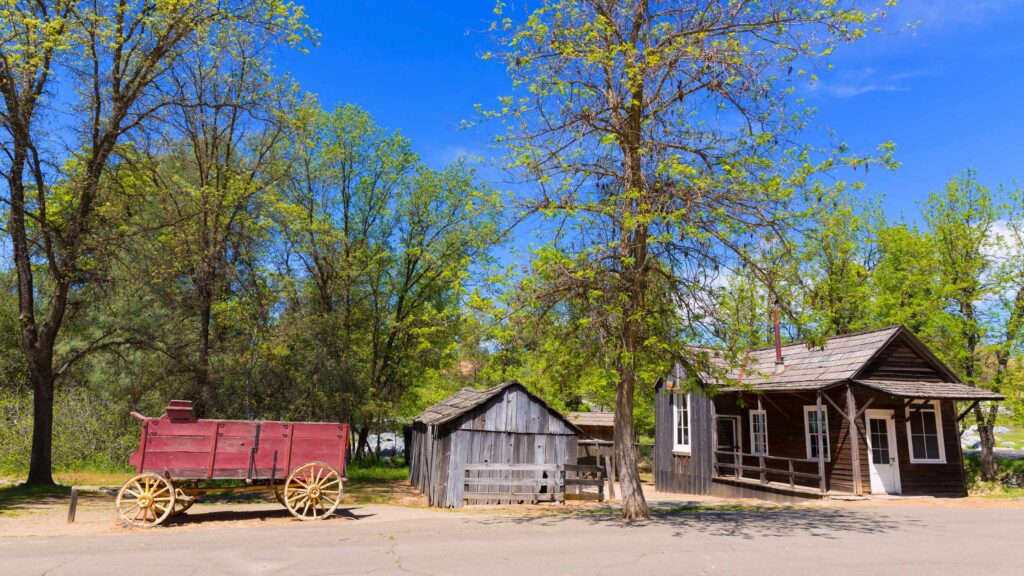
Old Town Auburn is known for its many fine dining restaurants.
So, plan a date night with your loved ones, grab a beer, or enjoy a glass of wine from one of the cosy downtown places.
You must visit Auburn in mid-December to experience the vibrant festive spirits of Old Town Christmas.
If you plan to drive Highway 49 while you are in Auburn, check out this self-guided audio tour of the historic highway. If you are looking for car rentals, you can check out Discover Cars.
BODIE GHOST TOWN
Bodie Ghost Town is one of the abandoned Gold rush towns California, located in Mono County, East of the Sierra Nevada, which was once a thriving mining town.
Bodie Ghost town was founded in 1859 after a group of prospectors discovered Gold in the area. The city was home to roughly 10,000 people during the Gold rush era.
During the late 1800s, Bodie Ghost Town was home to brothels and lavish gambling bars and was almost infamous for its lawlessness.
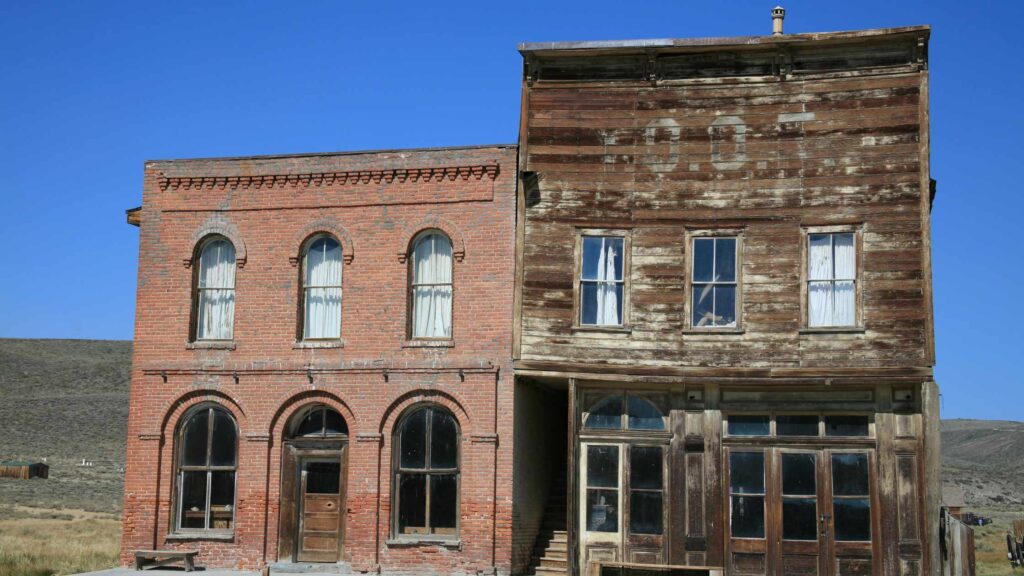
The Gold rush in the town did not survive for too long, and the town’s population was slowly reduced to a handful.
Today, Bodie Ghost town is a well-preserved California historical landmark which stands as a reminder of the Gold Rush days with abandoned buildings with original furnishings.
Visit the Bodie State Historical Park, located on Highway 270 at an elevation of around 8000 feet.
Three miles drive on the bumpy road, and you will be transported back to the Bodie Gold Rush era. This is so well preserved that you might feel like you are in a movie set.
Walk around between old buildings, and peep into the windows to see what living spaces were like back then.
There is a dance hall which entertained thousands of miners, a jail, a barber shop, a general store, a fire station and much more.

The entrance fee is $8 per person, and you must pay approximately $3-$4 for a guided park ranger tour.
Check out the Museum, which houses exhibits from the gold rush days and artefacts depicting the history of Bodie Ghost town.
If you are driving or on a road trip between Death Valley and Lake Tahoe, take a pit stop by this Gold rush town as it’s just off Highway 395.
WHERE TO STAY IN BODIE GHOST TOWN?
Also, the best places to stay are about an hour and a half away at June Lake or Mammoth Lakes.
COLOMA
Coloma, a quaint hamlet located in El Dorado County, approximately 30 miles North-East of Sacramento, is one of the first Gold Rush Towns in California.
Coloma is also one of the famous gold towns in California, which attracts historians, museum buffs and other outdoor adventure-loving enthusiasts.
Take a tour of the Marshall Gold Discovery State Park, the place where James W. Marshall discovered Gold for the first time in 1948.
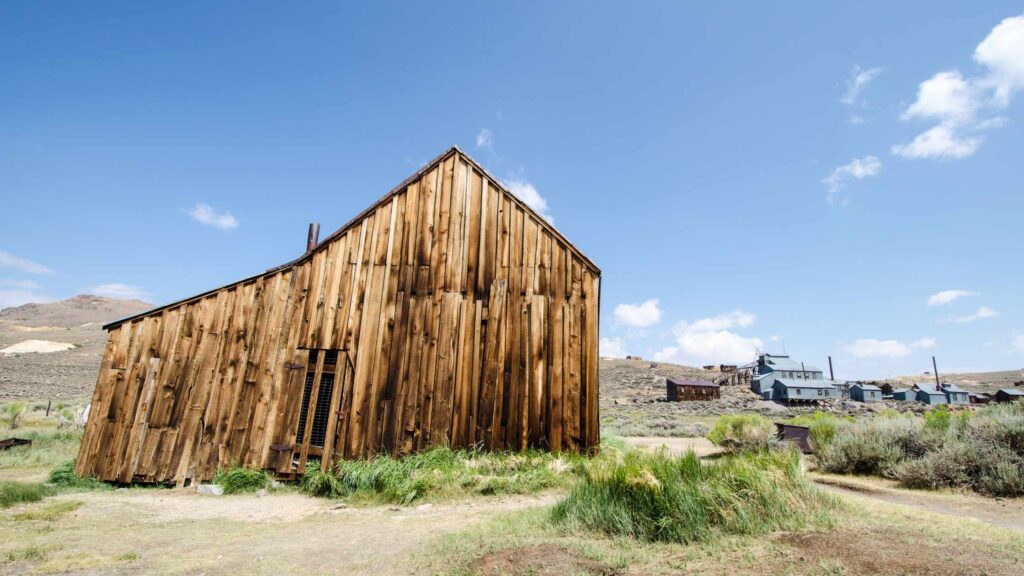
The State Park is vast and features an interactive exhibition that includes a replica of the Sutter’s Mill, which was constructed when Marshall found the first few nuggets of Gold.
Browse the Museum to learn about Coloma’s Gold mining history. Marshall Gold Discovery State Park also features several hiking and picnic trails which offer beautiful vistas of the distant Sierra Nevada range.
If you visit this place on Saturday, you might bump into many artists recreating the scenes of the Coloma Gold rush era days through their beautiful plays and narrations.
Stroll along the trails of the South Fork of the American River. Since Coloma is one of the first CA Gold Rush Towns, it is only fitting that you should experience it first-hand.
Rent a gold-panning kit from local vendors to try your luck, or take guided gold-panning lessons from the local prospectors.
The river is also a hotspot for white water rafting and Kayaking.
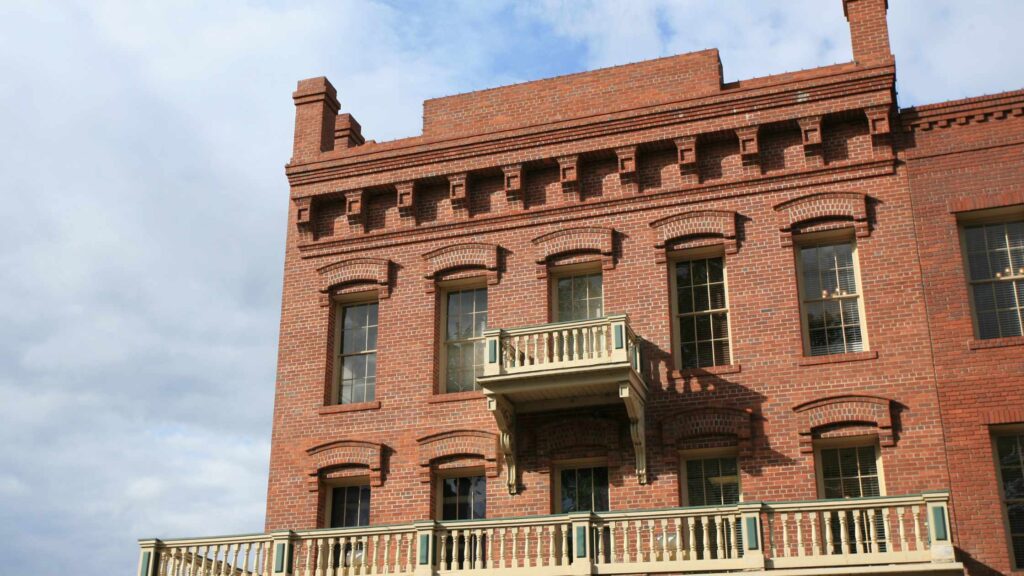
The surrounding lush hilly terrain is home to beautiful hiking and mountain biking trails, and there are also ample camping options amidst the woods along the river.
Visit the Coloma Outdoor Discovery Centre to learn about the area’s natural history, local flora and fauna and participate in educational events at this centre.
Alongside the Marshall Gold Discovery State Park off Highway 49, there are many cosy cafes to grab a snack or sip a coffee.
If you have spare time, visit other historic sites near Coloma, including the 19th-century Oroville Chinese Temple, about 80 miles North of Coloma.
CALICO GHOST TOWN
Calico is one of the Silver mining towns in California, located in the heart of the Mojave Desert.
If you are on a road trip from any of the best beach towns in California towards Las Vegas or Death Valley National Park, you can stop over to explore this ghost town.
Calico, one among the list of old west towns in California, was established in the late 1800s and was a bustling Silver mining camp. Around 500 mines were operated at full scale, generating over $20 million over 12 years.
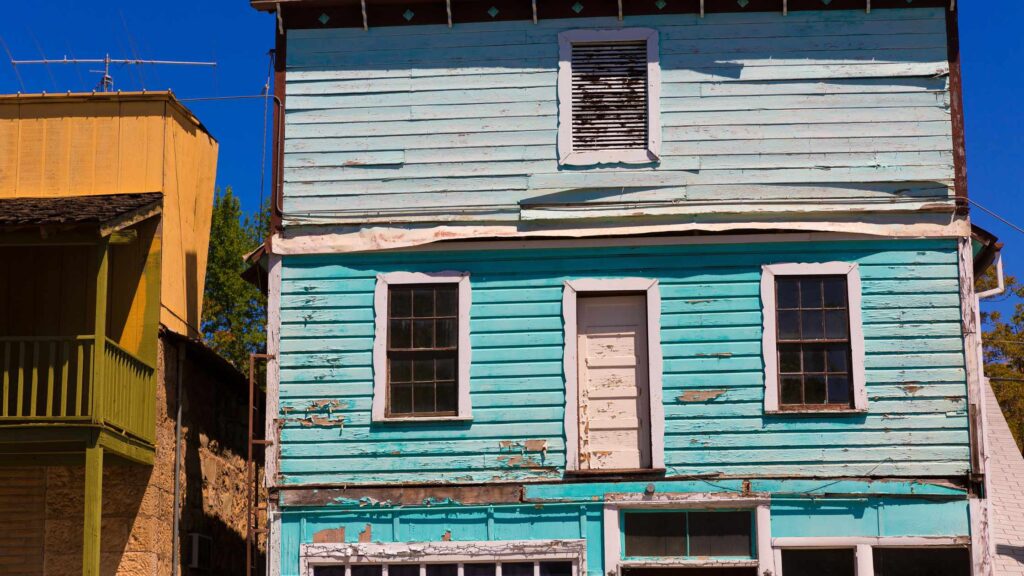
Eventually, the mines dried up, and so did the population. By around the 1900s, Walter Knott purchased this town and developed Knott’s Berry Farm, quickly attracting tourists across the state.
Although Calico was not among the Gold rush towns in California, it still had some mines in Gold during the Gold rush era. But predominantly, Silver was mined more than Gold in this region.
Today, Calico Ghost town is a well-preserved State Park, and you can explore the town via guided tours of the Museum to gain insights into the life of Gold and Silver miners who inhabited here in the Wild West.
One of the unique and fun ways to explore Calico Ghost Town is to take the Calico & Odessa Railroad ride. This miniature train winds through the desert and offers incredible vistas.
For a more interactive and a bit old-fashioned experience, join a fun stagecoach ride, take the gold panning adventure or try shooting a replica gun in the gun fights.
WHERE TO STAY IN CALICO GHOST TOWN
PLACERVILLE
Placerville, located in El Dorado County, is known for its rich history, stunning scenery, and gateway to the Sierra Nevada Mountains. It is one of the gorgeous Gold Rush Towns in California.
The town was founded in the mid-1800s by a group of miners. This place was previously called Hangtown since it was infamous for its lawlessness and vigilantism.
Eventually, the place was named Placerville due to the development of the Placer method of Gold mining in this region.
Miners around this region used Pans and Placers, which sifted through sand and dirt to find Gold in the rivers.
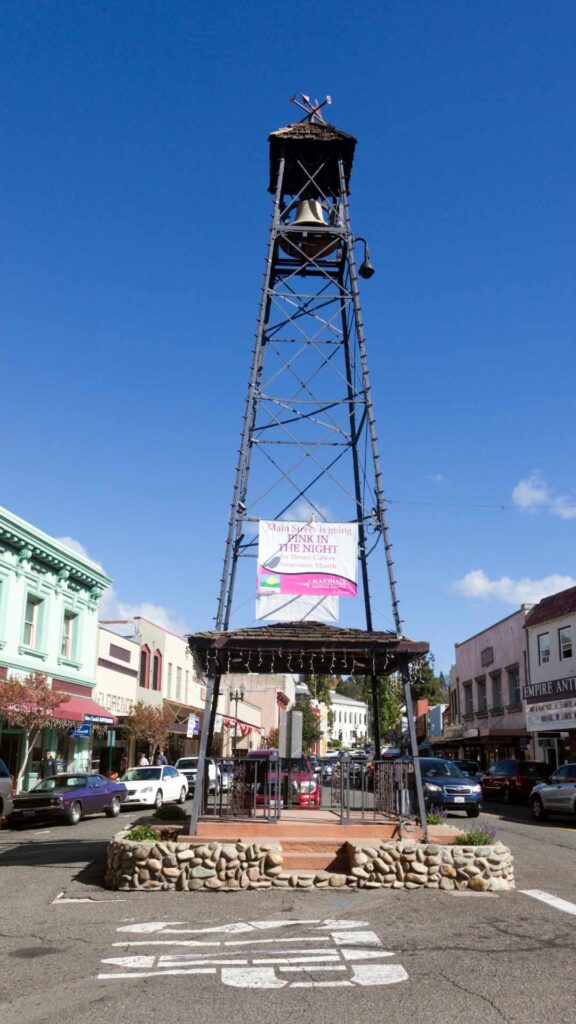
Historians say that a whopping $25 million worth of Gold was extracted from this town, supposedly the third largest in California.
Currently, Placerville is a well-preserved town with many historical buildings and museums.
Visit Hangtown’s Gold Bug Park and mine to learn about the local gold mining history. You will witness a working Blacksmiths Shop, a museum, and a Stamp Mill, and you will get an opportunity to pan for gems.
Take a guided tour of the underground mine and look out for the park’s various programs throughout the year.
Visit the El Dorado County Historical Museum, which throws light onto the lives of Placerville residents.
The outside area of the Museum has exhibits centred around mining, ranching, agriculture, and narrow-gauge railroad logging activities.
Inside the Museum, there are different displays and a staffed reference library.

Try to visit on a Sunday to experience the El Dorado Western Railroad’s historic gang cars, which railroad workers once used.
Spend time shopping in the Historic downtown of Placerville. The downtown is dotted with some of the oldest buildings, which narrate the town’s history.
There are many unique shops, boutiques and restaurants to explore.
Check out the nearby Bell Tower, which was once used to alert the local fire brigade.
If you want adventure, check out Placerville Speedway, which hosts a series of events throughout the year, including motocross events and stock car races.
Enjoy the Placerville County Fair if you visit the town during Summer. The fair features live music, carnival rides and fantastic mouth-watering delicacies on food carts.
Check out the Placerville Hardware on Mainstreet, one of the oldest hardware shops, along with many gifts and souvenirs on the shelf.
JULIAN
Julian, located in San Diego County, is one of the lesser-known Gold Rush Towns in California.
Fred Coleman discovered Gold in Julian in 1870, a few years after the original gold rush had passed. Julian quickly became a boom town with many different businesses, hotels, saloons and restaurants.
Though the Gold rush era was short-lived in the town, it had a rich gold mining history from 1870 to 1900.
There were 200 gold mines in operation in the area of Julian during this period.
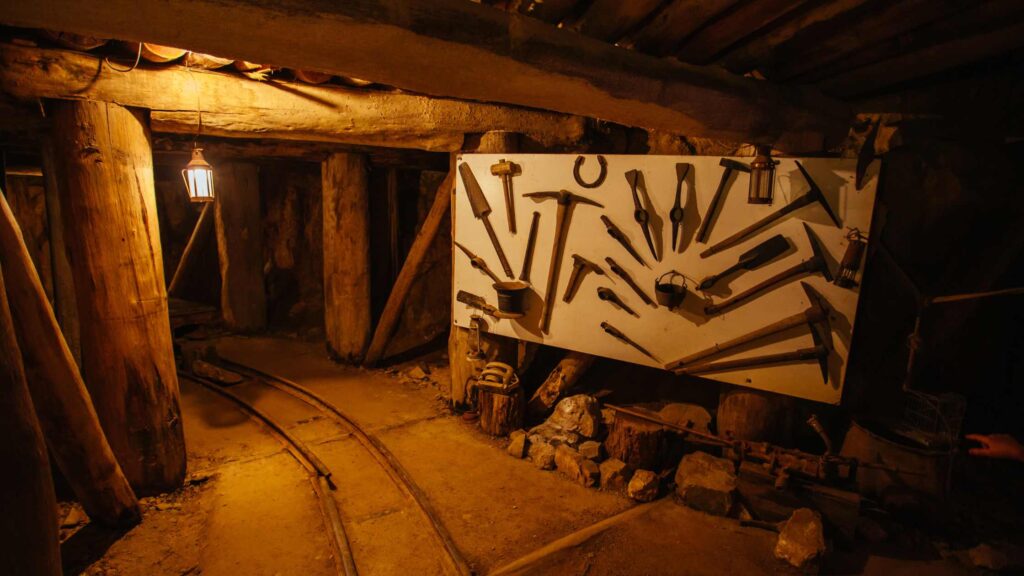
Today, relive the rich history of gold mining by taking a guided tour of the Eagle and High Point Gold mining company.
A nicely restored historical gold mine home to 4,000 feet of tunnels and 11 levels, with a maximum depth of 425 feet, the Eagle Mine was the most prosperous gold mine. It extracted around $400,000 in Gold before closing in 1934.
Recommended – 25 Fantastic Things To Do In Julian With Your Family This Year
The tours, which last about an hour, provide access to the Museum, underground tunnels, and gold panning areas.
It will help you understand the detailed mining process, the history of the mine, and the dark and cramped conditions miners were subject to for 12 hours a day.
After the tour, you can enjoy a picnic lunch on the historic grounds.
Visit the Julian Pioneer Museum, which throws light on Native American history.
Check out my exclusive list of things to do in Julian if you want to spend more time in Julian.
WHERE TO STAY IN JULIAN
Julian Gold Rush Hotel – This is a top place many tourists favoured. This lavish hotel comes with a terrace and a beautiful garden. Check prices to book here.
Wikiup Hummingbird Hotel – Wikiup Hummingbird Hotel is an excellent pick if you are traveling with kids as they have spacious suites and incredible views. Check prices here.
APARTMENTS, RESORT AND SPA
Oakzanita Springs Camping Resort Cottage 4 – If you are looking for a rustic stay with your family, I recommend Oakzanita Springs Camping Resort Cottage, located in Descanso in the California region, known for its well-made suites and located in an excellent place. Check details and availability here.
Quiet Mind Mountain Lodge, Retreat & Spa – This 4-star hotel has luxurious amenities, including a pool and playrooms. All lavishly decorated suites come with a patio. Check details and availability here.
Riviera Oaks Resort By Diamond Resorts – Nestled in the San Vicente Valley, Riviera has beautiful one to two-bedroom villas. Check more here.
AMADOR CITY
Amador city, a small city located in Amador County, was one of the first Gold Rush Towns in California.
The town became prominent when Gold was first discovered in 1848 by a miner named Jose Maria Amador.
Amador slowly gained popularity, and two stamp mills were established to extract quartz Gold from the unnamed creeks on the West.
The city has many historic sites, such as the Amador Hotel, listed on the National Register of Historic Places, Little Amador railroad, which features remnants remain of the miniature mines and railroads of the Gold rush era in this region.
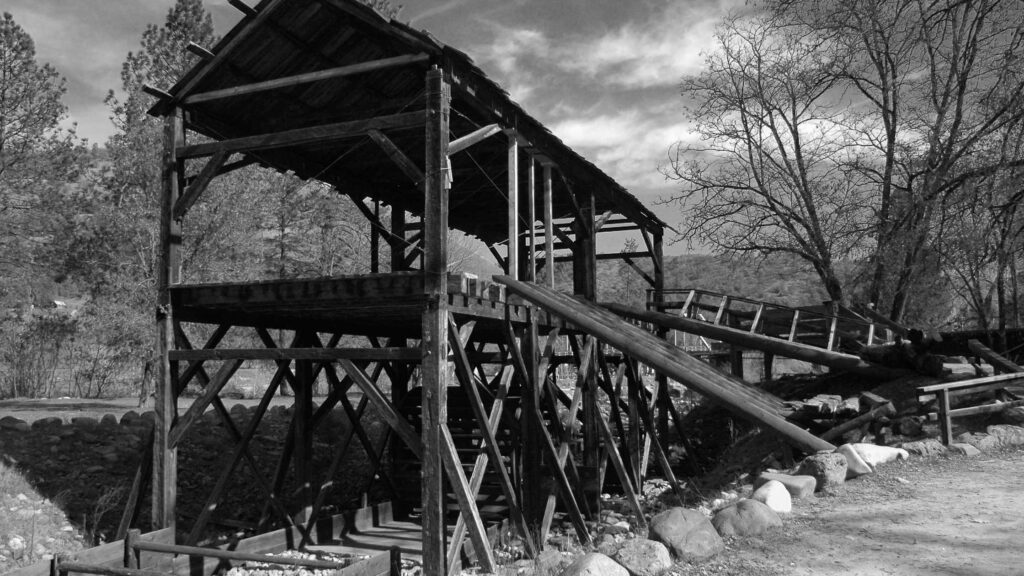
Check out the Amador City Cemetry and the Amador Whitney Museum, which collects and preserves artefacts related to the Mother Lode region.
Amador downtown is also lined up with many wineries. Pick up your favourite bottle of wine from one of the wine-tasting rooms.
Visit the quaint shops on Main Street. Some shops also offer locally sourced products. The city also hosts several festivals like the Wine and Food Festival in Spring.
JACKSON
If you want to explore the world’s deepest Gold mines, visit Jackson, one of the top Gold Rush Towns in California, located in Amador County at the intersection of Highway 49 and 88.
Jackson, founded in 1848, was named after Colonel Alden Jackson. It was one of the significant Gold Rush mining towns during the 1800s.
Thanks to Kennedy mines, one of the world’s most productive and deepest mines with a depth of 5912 feet.
As per the data,50% of the Gold of the Mother Lode was produced by Kennedy mines over 82 years and is estimated to be worth around $32 million.
The city was almost devastated by a fire incident in 1862, but it was rebuilt later.
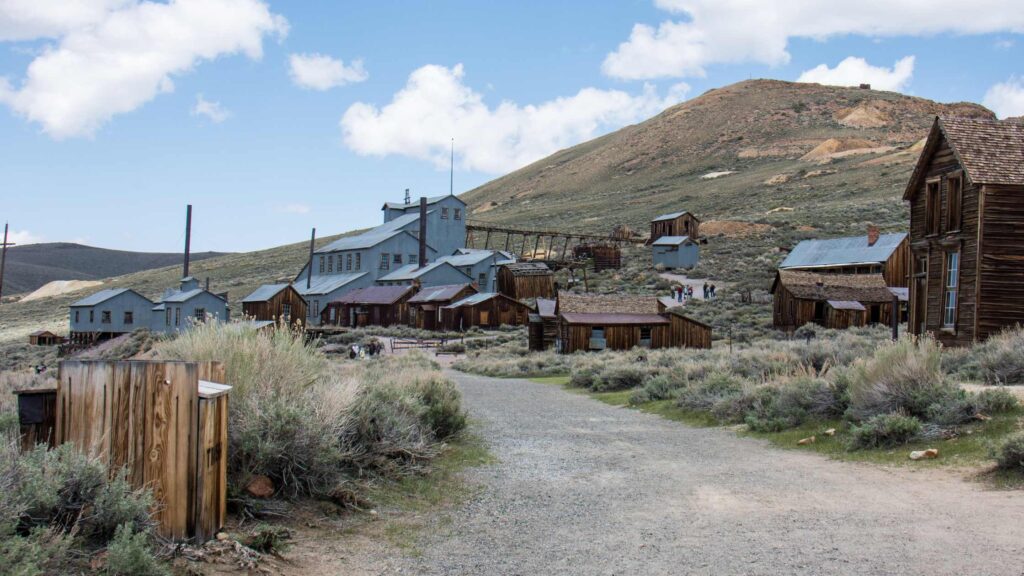
Take a guided tour of the Kennedy Gold Mine to learn about the hard rock mining process.
In the initial days, the placer method was used in this region, but due to the abundance of Gold, the extraction process was switched to hard rock mining.
If you don’t prefer to go undergrounds, many surface-level tours are available, taking you through the exhibits and mining equipment.
Take in the vibes of the place where Gold was melted into bricks, which were shipped to San Francisco back then. Can we imagine something like a scene from Money Heist? Oh boy! this was way more than that!
Check out the nearby Amador County Museum, located 2 miles away from the Kennedy Gold Mines. This place, housed in the Greek revival building, was established in 1859 and was the home of the Brown family.
Browse the 15-room lavish building, with artefacts describing Native American history, quilts and other fashion wears from the past, a Chinese American exhibit and some artefacts related to the gold mining history.
Take a guided tour to learn more about the region’s Gold mining history. The main draw of this Museum is the large-scale replicas of the Kennedy Mine and the North Star Mine in the complex.
When you feel contented getting soaked in the massive rich history of Californian Gold, stroll the charming main street adorned with various art galleries and gift shops. Try assorted handmade jewellery or shop for your antique collections.
Check out the nearby infamous “Hanging tree”. Enjoy a glass of wine while you imagine how this city must have been bathed in Gold during the Gold rush era.

If you want to extend your stroll beyond Main street, check out the churches, cemeteries and other beautiful historic homes dotting the downtown.
Check out the self-guided historic walking tour, one of the unique ways to explore Jackson. Request a map at the Sutter Creek or Jackson Chamber of Commerce and explore the 25 historic buildings and sites.
If you are looking for other outdoor activities in Jackson, go fishing in the nearby Creeks or hike the beautiful trails of the surrounding mountain ranges.
Visit the Indian Grinding Rock State Historic Park, 20 minutes from Kennedy Gold Mines. This park is home to a massive collection of bedrock mortars used by the Native Miwok tribes for grinding acorns and other food items.
Besides Gold, Jackson is renowned for many events throughout the year, which include the Lions Club Dandelion Days Flea Market, which happens in Mid-March, the Gold Country Cruise Car Show, which occurs in mid-May and Amador County Heritage Days in October.
If you have spare time and are a wine lover, visit Plymouth to enjoy beautiful vineyard vistas and wineries for various wine tours. Plymouth is also home to the Amador Flower Farm and varieties of vibrant flowers.
MURPHYS
Murphys is one of the old West towns in California, nestled between Lake Tahoe and Yosemite National Park in Calaveras County.
It was founded in 1848 by John and Daniel Murphy, two brothers who bought the wagons over Sierra and led the westward migration.
Although the town was set up on fire thrice, it is estimated that the Murphy brothers extracted $2 million worth of Gold, with which they became lavish millionaires by their mid-20s, and Murphys became one of the most successful Gold Rush towns in California.
Eventually, when the Gold waned out from the “Queen of the Sierras”, Murphys, people started working in other farms, stores and sawmills. Later, the town got its reputation for one of the best world-class wines.
Visit the Ironstone Vineyards, a massive beautiful property with a well-equipped Amphitheatre, a water wheel, gorgeous trails and lakes, besides the lavish wine-tasting rooms.
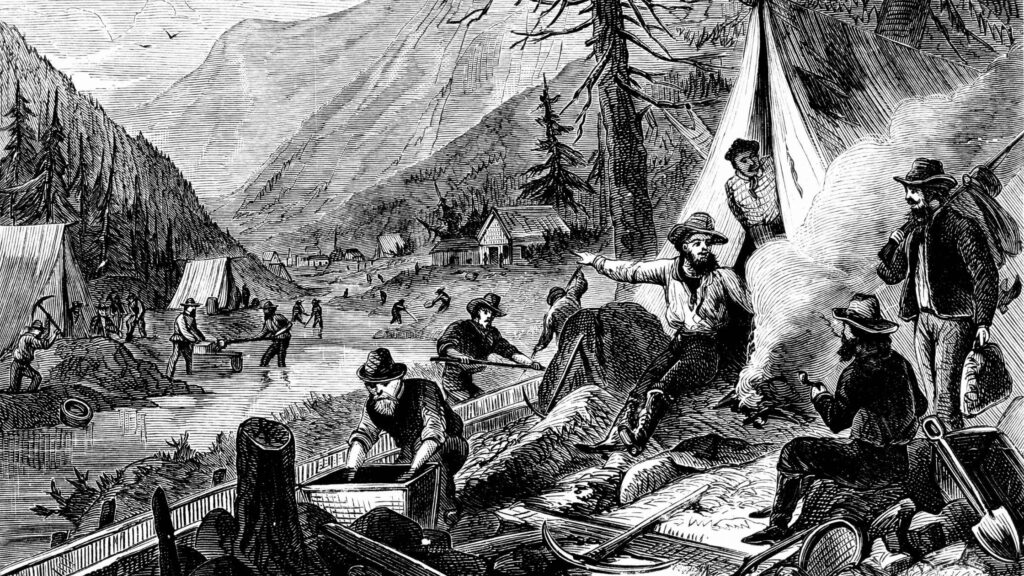
The main draw of Ironstone vineyards is its onsite gold mining museum and jewellery shop, which features the largest single piece of Gold ever mined in North America, the Kautz specimen, which weighs 44 pounds.
Stroll on Main Street, and wine and dine in the Murphys Historic Hotel, which once hosted famous visitors like Ulysses S. Grant and Mark Twain.
Visit Murphys Old Timers Museum, which was built in 1856. The Museum intends to preserve Murphy’s history. Browse exhibits that include early settlers’ artefacts like Native American baskets and clothing.
If you are a fan of giant Sequoias, visit Calaveras Big Trees State Park, located at a 25-minute driving distance from Main street.
The park is filled with verdant forests and towering sequoias, some of which are endangered. Pay an entrance fee of $10 and enjoy hiking beautiful trails amidst the North and South Grove sequoias.
Calaveras Big Trees State Park is a wonderland during winter; you can do snowshoeing and camping, and the park has well-maintained camping grounds.
Besides Gold and wine, Murphys has several annual events like the Murphys Irish Day Parade and Street Fair in March, the Jumping Frog Jubilee in May, and Grape Stomp in October.
MORE GOLD RUSH TOWNS IN CALIFORNIA
SUTTER CREEK
Sutter Creek is a quaint town located in the foothills of the Sierra Nevada, an hour away from the Murphys.
Founded in the mid-1800s, the city got its name from its long-time resident John Sutter, who tried his luck mining gold in this region.

Sutter Creek switched to hard rock mining from the traditional placer method and became one of the prime supply centres among the Gold Rush towns in California.
For an overview of Sutter Creek’s mining history, stroll on Main Street and visit Miners’ Bend Park. The park has unique equipment and sculptures depicting the town’s mining history.
Take a tour of the Roaring Camp Mining Company, return to the 1850s and learn to pan Gold at this site.
Check out the 1896 Monteverde General Store Museum. Though most of the town eventually changed, this store is in the same condition.
Legend says the store’s original owner left a note that it would be closed for a few days, but they never opened it again.
Today you can see the original note and many other artefacts sold in this store in the 1900s.
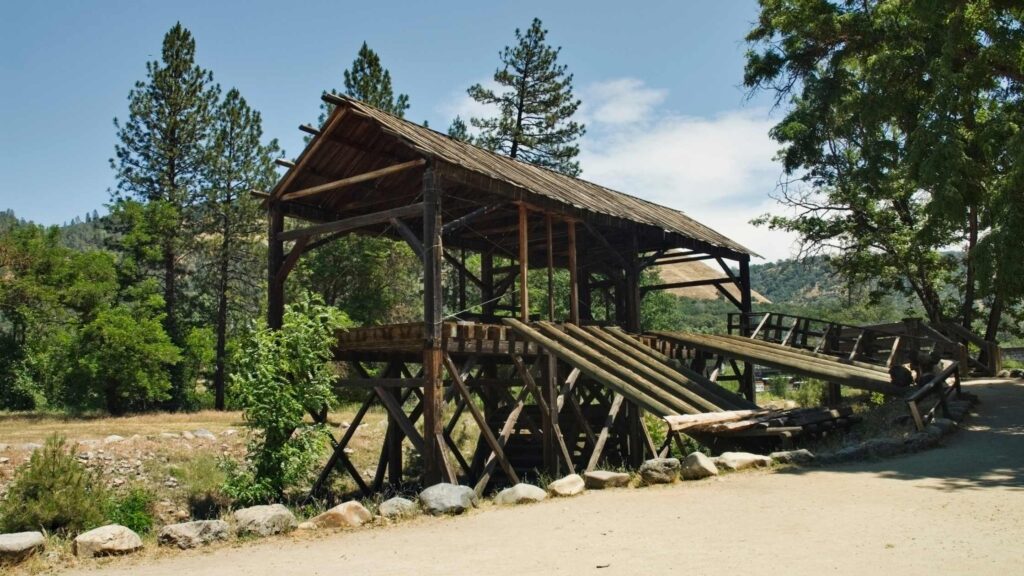
On a walking tour, explore the vibrant Downtown Sutter Creek, home to many historic buildings. The streets are dotted with wine-tasting rooms, boutiques and multicuisine restaurants.
For a dose of your evening entertainment, visit Sutter Creek Theater to enjoy live music concerts and other plays.
And lastly, Sutter Creek is one of the top-notch wine regions in California. Surrounded by El Dorado County’s Fairplay region, the Amador Valley’s Shenandoah Valley and Calaveras County’s wine region Sutter Creek can be added to your weekend trip itinerary for wine-tasting.
MOKELUMNE HILL
One of the wealthiest Gold Rush towns in California, Mokelumne Hill, is located in Calaveras County and is one of the California Historical Landmarks.
The town gets its name from the adjacent Mokelumne River, used by the Miwok tribes and then native settlers.
Gold worth thirty million dollars was estimated to be extracted from this site. As the town boomed during the Gold rush era, the city became infamous for its notorious crimes and lawfulness.
Today, you can enjoy the views of some of the iconic buildings in the town. Check out the Historic State Park, which includes the ruins of a stagecoach.

Visit the Congregational Church, one of the oldest buildings in the region. Check out the IOOF Hall, the first three-storey building to be erected in the town.
Mokelumne Hill is also home to many art galleries, museums, antique shops, and restaurants.
Check out the various wine-tasting rooms on the main street and enjoy shopping in the cute boutique shops along the road.
If you visit the place during September, you can check out the Mokelumne Hill days event, which features live music, a parade and many food stalls with local delicacies.
SAN ANDREAS
San Andreas, located near the confluence of the North Fork and South Fork Calaveras Rivers, was settled by Mexican miners and was initially a tiny mining campsite.
But when Gold nuggets were found in the underground river channel, San Andreas became another famous mining town in California, contributing to the Gold Rush Era.
The initial nuggets were sold for around $12,000. Stamp mills were established near the Stanislaus River, and quartz vein stringers were extracted from around the hill.
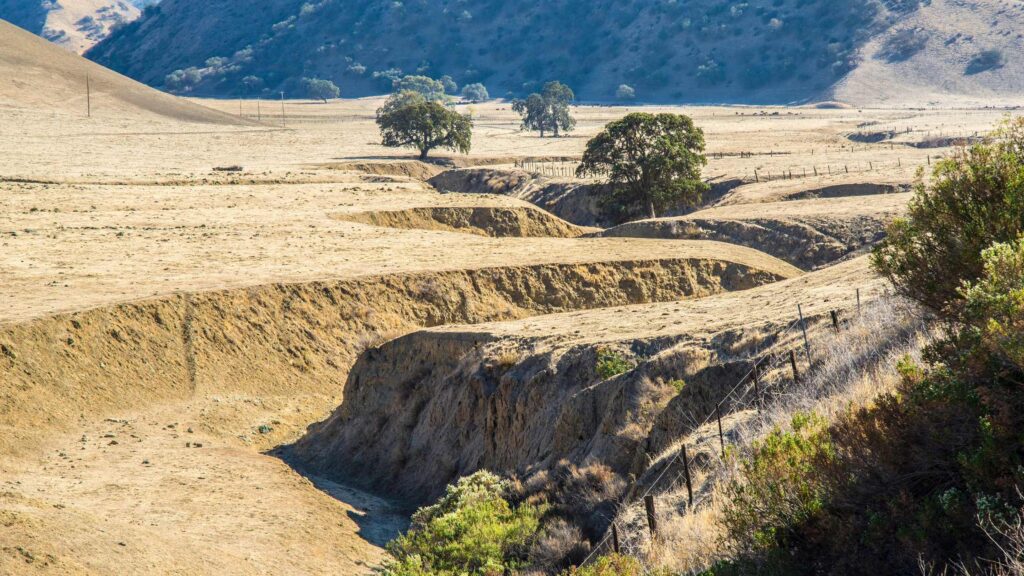
There are many historic buildings on the Main street of San Andreas. Check out the Calaveras County Museum and Historical Society to learn about the history, people and notorious outlaws of Calaveras County.
Wine lovers can check out the nearby Chatom Vineyards. There are many wine-tasting rooms on Main Street as well. Enjoy the lively art and music scene on the Main street and grab a snack from one of the local’s favourite restaurants.
Visit the nearby Calaveras Big Trees State Park if you have spare time. A great place to take in the views of some of the biggest giants in the world and a perfect camping location.
COLUMBIA
If you are looking for one of the wealthiest Gold Rush Towns in California, visit Columbia, nestled amidst the rugged oak woods on the western slopes of the Sierra Nevada in Tuolumne County.
Often referred to as the Gem of the Southern Mines, Columbia was founded in 1850 and was home to many miners, merchants and other entrepreneurs.
The town had a bustling main street, elegant saloons, gambling bars and hotels. Over one billion dollars worth of Gold was estimated to be extracted from Columbia.
Columbia is now a National historic landmark and has been transformed into Columbia State Historic Park.
You can grab a free booklet of the town and take a self-guided tour at your place, relishing the history of this Gold rush town.
Stroll on the pedestrian-only main street dotted with around 30 iconic buildings restored from the Gold rush era. Visit the working blacksmith shop or learn Gold panning.
Take the fun stagecoach ride along Main street or check out historic buildings like Columbia Mercantile, where you can also taste a cold sarsaparilla drink.

Enjoy the famed Sierra Repertory Theatre performances at the historic Fallon Theatre.
Columbia also has unique local businesses, such as the Columbia Candy Kitchen and the Columbia House. These stores often offer a variety of old-fashioned treats, including handmade fudge and other confections.
Don’t miss grabbing a scoop of ice cream at the local’s favourite Fallon Ice Cream Parlor.
Try visiting the town on the second Saturday of the month to see special gold rush-era exhibits and hands-on activities. Dress up in the 1850s period clothing, and take as many pics as you want to flaunt on your ‘gram!
Check out the special events like Back to School Day, lamplight tours, and the Miners’ Christmas festival organised by the volunteers.
SONORA
Located at the South end of the original Mother Lode, close to Yosemite, Sonora is one of the charming Gold Rush Towns in California, founded in 1850 by a group of miners from Mexico.
They named the city after the Mexican state of the same name. Sonora was often called the “Queen of the Southern Mines” since it was the largest mine with a population of around 15,000 miners.
Today Sonora is a quaint city with a population of less than 5000. Sonora Washington Street, part of Highway 49, is its historic core and the central downtown.
The main street has historic buildings, antique and gift shops, and boutiques.
Start exploring this beautiful gold rush town from the Visitor Center on the Southern end by grabbing a city map. Pick up an old-fashioned Candy from the Candy Vault.
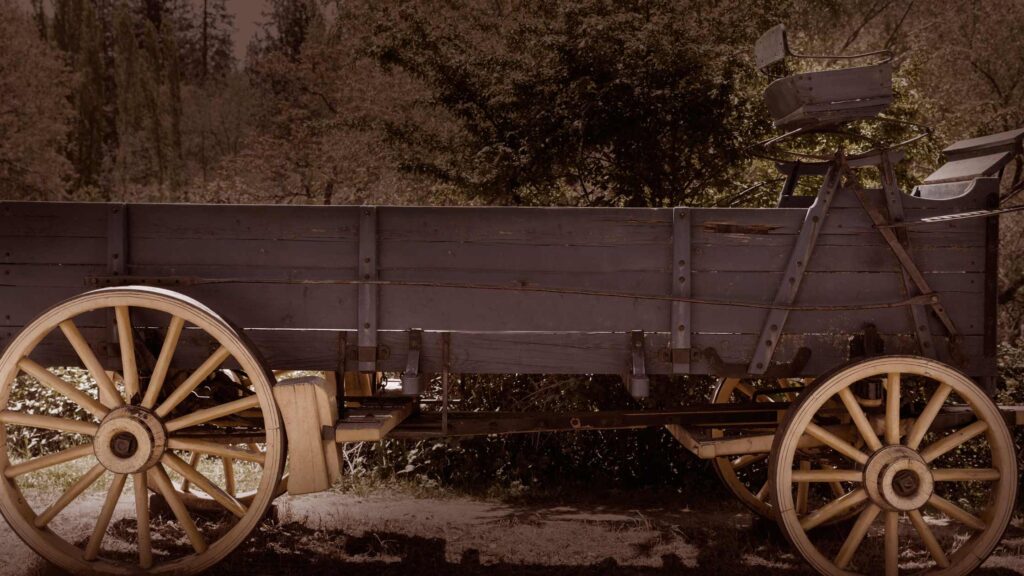
A few miles from the visitor centre will lead to the Sonora Opera House, built with funds generated by the local Bonanza Gold Mine.
The Opera house was originally a flour mill but was converted into the Opera Hall after a fire incident. The hall was a centre spot for many community-based events, political rallies, meetings and other private events.
Check out the Tuolumne County Museum and History Center, the county jail until 1960. The Museum narrates the stories from the local Native American tribes to the Gold rush miners.
Walk a few meters to the other end of the Museum and find the historic Red Church built in 1859 and the Sonora Fire Museum and Senior Lounge.
If you are interested in hiking, hike the Dragoon Gulch Trail, which runs through Mother Lode’s oak woodlands and offers incredible vistas.
Don’t miss the Farmer’s market on Saturday mornings to buy fresh farm produce, baked goods, and other homemade products like jams, jellies, vinegar and oils.
JAMESTOWN
Located adjacent to Sonora, just at a driving distance of fewer than 4 miles and nestled between New Melones Lake and Lake Don Pedro, Jamestown is another small unincorporated community and one of the best Gold Rush Towns in California.
Designated as a California Historical Landmark, Jamestown takes the credit for the first Gold discovery site in Tuolumne County.
Also, thanks to its gorgeous scenery, around 200 Hollywood movies and TV shows have been filmed here.
If you are a movie buff and want to see the locations of all the Hollywood movies that were shot, Stroll on the Jamestown Walk of Fame stretches from Railtown 1897 to Rocca Park. Check out the iconic buildings like the National Hotel and Restaurant.
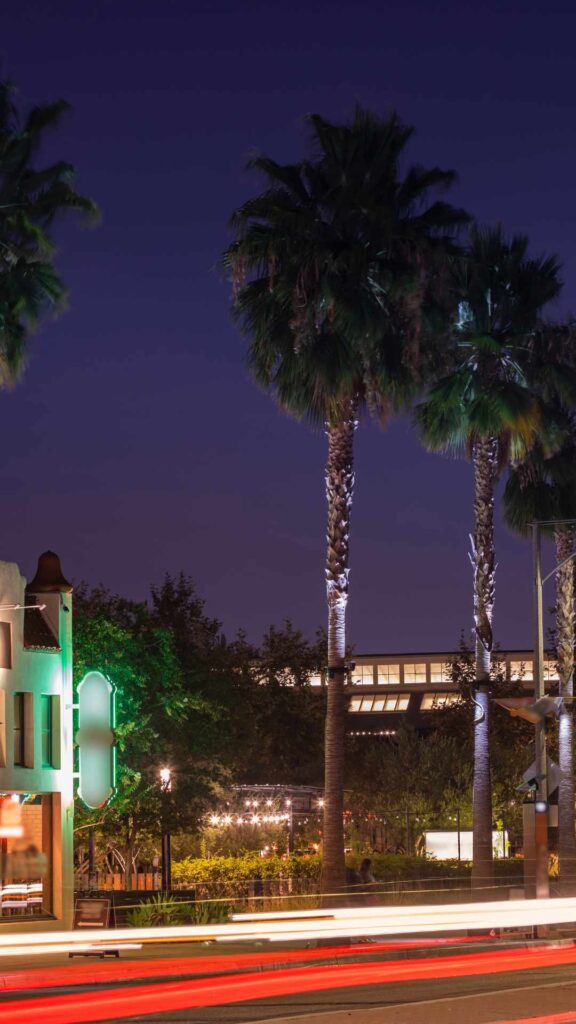
Visit the Railtown 1897 State Historic Park, Jamestown’s main draw, which takes you through the town’s railroad history.
Take the 45-minute excursion that runs every weekend.
The park is home to the iconic locomotive Sierra No.3 engine, featured in at least 80 Hollywood movies.
Take part in one of the volunteer-led docent tours, and enjoy fun events like “Robbery on the Rails”. Don’t miss the famed “Polar Express” journey in winter.
Wood Creek flows through this beautiful town, and this was the hotspot where some rich gold deposits were found during the initial Gold rush days. Stroll along the creek’s trail and learn Gold panning.
Browse the many boutiques and galleries downtown and enjoy wine and beer tasting.
GROVELAND
Groveland is one of the lovely rural Gold Rush Towns in California located in the Sierra Nevada Mountains, at a 30-minute driving distance from Yosemite.
To return to the Gold Rush Era times in Groveland, visit the Groveland Yosemite Gateway Museum.
Click a picture along with the giant statue of the black bear, which greets you at the entrance. Browse various artefacts and exhibits to understand the history of early settlers of the region.
Like many other California mining towns, you will get a feel of the Gold rush era on Main Street in Groveland. The streets are adorned with many art galleries, boutiques, gift shops, saloons, bars and wine-tasting rooms.
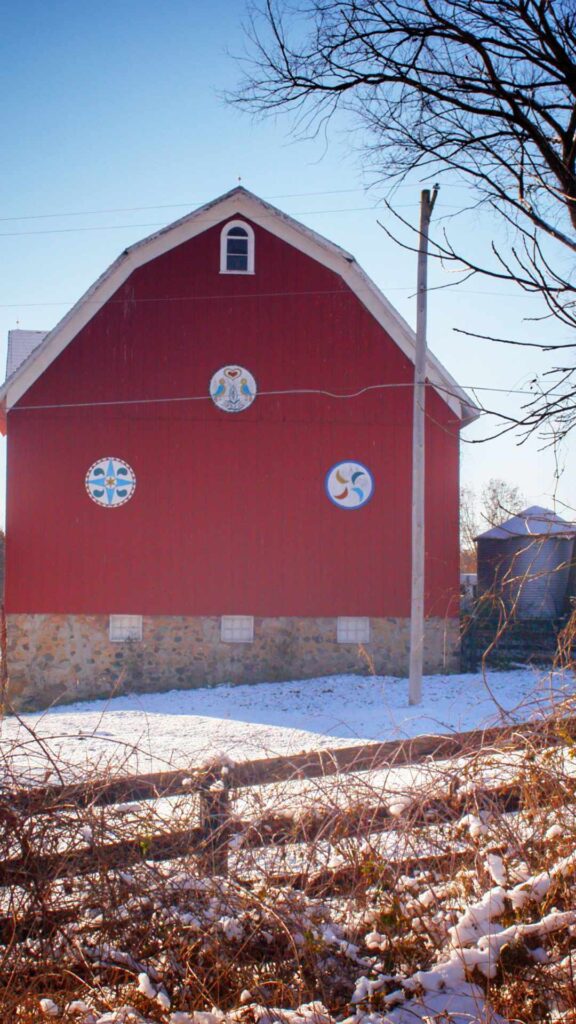
Have a drink at the bar in the iconic Iron Door Saloon, founded in 1852 and is supposed to be one of the longest continually operating saloons in the state.
Take a walking tour of the historic buildings on the main street, like the Groveland Hotel, Groveland Jail and the town hall.
Groveland is also a hotspot for vacation and other outdoor recreational activities, such as hiking, biking, fishing and swimming. The nearby Tuolumne River offers a variety of fishing options.
Avid hikers and campers can check out a wealth of hiking and camping opportunities at Yosemite National Park.
If you time your visit right, you can enjoy one of the many festivals that Groveland hosts throughout the year, like the Groveland Art & Wine Festival or the Groveland Music and Arts festival.
SACRAMENTO
Sacramento, a vibrant and diverse city and the capital of California, was one of the top booming Gold Rush towns in California.
Monterey was the capital of California until California officially became a US state in 1850.
Sacramento is home to several historic attractions which will take you to the Gold Rush era.
Visit the Old Sacramento State Historic Park, the Western terminus of the Pony Express, the first transcontinental telegraph railroad.
The park is dotted with around 50 iconic buildings, including museums, exhibitions, art galleries and other interactive experiences.
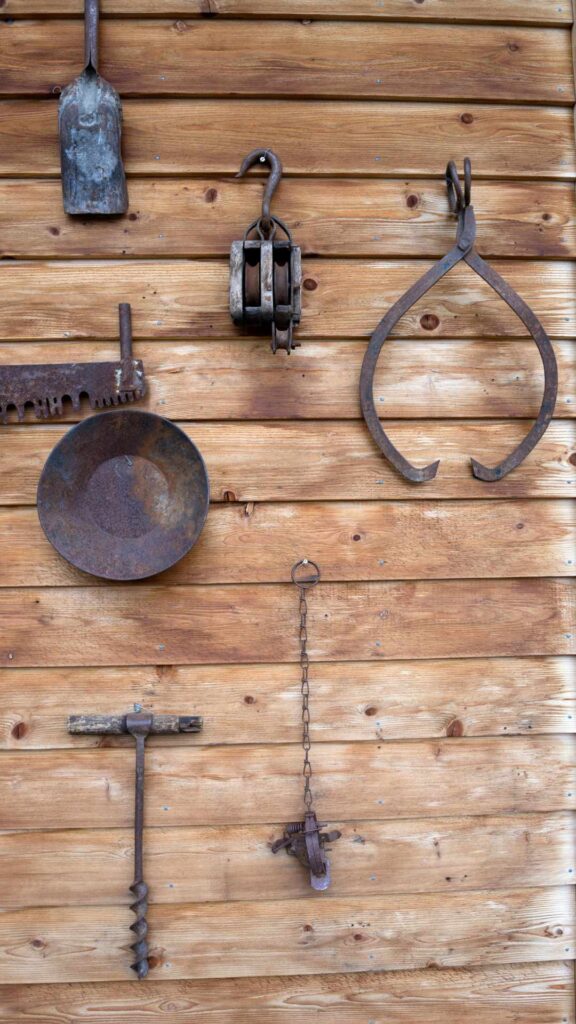
If you are a museum buff and want to learn more about this Californian Gold Rush town, visit the California State Railroad Museum. Don’t miss taking the riverside excursion train, especially if you are with kids.
The 50-minute train journey takes you through the beautiful landscapes of suburban Sacramento.
For more adventure, check out the underground tours at the Sacramento History Museum. There are also fun events like the scavenger hunt that will lead you through iconic spots of Sacramento.
Explore the Leland Stanford Mansion’s grand interiors a mile from the historic district.
The mansion was built in 1856 by Leland, an affluent businessman of the Gold rush era, who later became the Governor of California and founded Stanford University.
Check out the farmers market, which provides locals and visitors alike with fresh produce and other local goods.
Sacramento is also known for its diverse culinary scene, with various cuisines to choose from. Sacramento has something to offer for every foodie, from traditional American to Mexican and Italian.
FOLSOM
Known for its vibrant historic district, Folsom is one of the best Gold rush towns near Sacramento, established in 1849.
The early gold seekers in the region adopted significant placer gold mining during the Gold rush era. Gold worth million$ was extracted from this one of the gorgeous Gold Rush Towns in California via dredging, which became a significant profession for the gold seekers.
Stroll on the Folsom Historic District. The area is home to numerous shops, restaurants and other interesting buildings.
Check out the nearby Folsom Powerhouse State Historic Park, built in 1895, another great place to learn about the region’s rich history. The park still features vintage generators.
Enjoy a movie or performing arts night at the historic Folsom Amphitheatre. Visit the Folsom Farmer’s market for fresh produce.
For museum lovers, there are a couple of museums which depict the development of Folsom.

Visit the Folsom Railroad Museum, home to many antique railway exhibits. The main draw of this Museum is the turntable used to pivot locomotives: it was initially built in 1867.
Visit the Folsom History Museum, which features exhibits of the early settlers who lived in the area along with rare artefacts from the Gold rush era.
Check out the Folsom Prison Museum, which throws light on the life inside the prison walls. It has some disturbing artefacts, like the ropes used to hang prisoners.
If you want outdoor activities in Folsom, visit the Folsom Lake State Recreation Area, which is home to Folsom Lake and Lake Natoma, a relaxing place to unwind.
The area is known for adventure activities like fishing, swimming, boating and stand-up paddleboarding. There are also miles of hiking trails for those who like to take in the incredible scenery.
Check out this self-guided audio tour, a unique way to explore this Californian mining town. You can book the tour here.
MARIPOSA
One of the charming towns on the El Camino Sierra road, now called Highway 49, is Mariposa town, located 1 hour from Yosemite National Park.
Mariposa is a Spanish word for butterfly, and the city got its name due to the many butterflies in the region. Mariposa was founded on a Mexican land grant to General John C. Fremont.
Fremont had initially designed the streets and layout of Mariposa. The buildings were built using stone, brick and adobe and are still used without restoring the architecture.
Take in the vibes of one of these beautiful Gold Rush Towns in California by strolling on the historic main street.
Visit the iconic Mariposa Courthouse, built in 1854, on Bullion street. This is the only courthouse in the West of the Rockies that is still in operation. So follow the local rules of the house and adhere to security checks when you are on the visit.
Check out the nearby Mariposa prison, also one of the fantastic photo spots in Mariposa after the Courthouse building.
Visit the Mariposa Museum and History Center, which takes you back to the Gold rush era to show the lives and stories of the people who built Mariposa in the late 19th century. The Museum has restored old dwellings and some blacksmith demonstrations.

Take a stagecoach ride on the Mariposa Stage Line across the street from the History Center to reach a reenacted Gold rush exhibit.
Visit the California State Mining and Mineral Museum, which features State’s official collection and unique gems, minerals and other artefacts.
The main draw of this Museum is the Fricot Nugget, a rare 13.8-pound piece of crystalline Gold found in the American River in 1864
The main street of Mariposa is lined with gift shops, art galleries, and antique stores to cater for your itch for shopping, along with multi-cuisine restaurants.
Mariposa is also an excellent place to enjoy the outdoors. The Merced river is a great spot for fishing, swimming and rafting. Try rock climbing, mountain biking or camping in the nearby Merced River Canyon.
This lovely mining town in California also hosts a series of events and festivals throughout the year. Check out the Mariposa County fair, Mariposa Music Festival, and the Mariposa Butterfly festival. In the summer, enjoy free evening concerts at Arts Park.
OAKHURST
Oakhurst, the largest town in Madera County, is the last on the chain of cities on Highway 49. Also, this is one of the gorgeous Gold rush towns in California, which serves as a gateway to the Sierra Nevada Mountains and Yosemite.
Oakhurst was mainly a logging camp and a supply town during the Gold rush era, which was used to bring lumber and other necessary supplies for the mining camps.
The town majorly supported mining at Coarsegold to the South, located near the Fresno River.
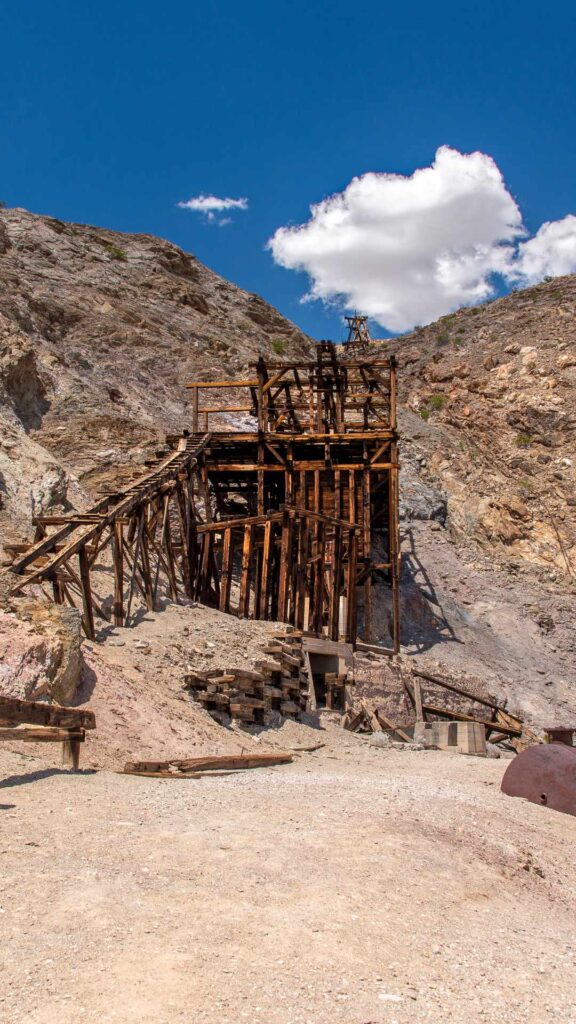
Oakhurst has managed to retain its small-town charm and, at the same time, offers excellent recreational activities like camping, fishing and mountain biking.
The town is also home to many wineries, giving visitors a unique opportunity to sample some of the local wines.
Check out the Oakhurst city centre, which has many beautiful antique shops, art galleries, museums and cafes.
The town hosts several events like the Oakhurst Brewfest, which features local beers and the Oakhurst Music Festival, which celebrates the local music scene.
GOLD RUSH TOWNS IN CALIFORNIA MAP
- Your Ultimate Guide to the Best Things To Do in Krakow, Poland - April 12, 2024
- Exploring the Hidden Gems of European Ski Resorts - March 28, 2024
- 25 Beautiful Landmarks In Poland For Your Bucket List - March 16, 2024




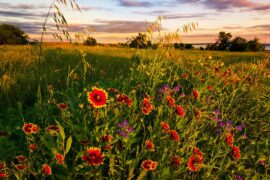
1 Comment
I’m glad you liked the gold rush part of California. I’m from Columbia (born in Sonora), my dad was born and raised in Jamestown, and his mother in Jacksonville, a now-underwater town a distance from Jamestown, Her husband (my grandfather) was born and grew up in Grass Valley. Between this relative and that, we go back to the 1850’s in the Gold Country, mainly of Cornish extraction, but Italian too, from about the 1890’s.
Again, thanks for the writeup about my home country.
Bill Tremewan